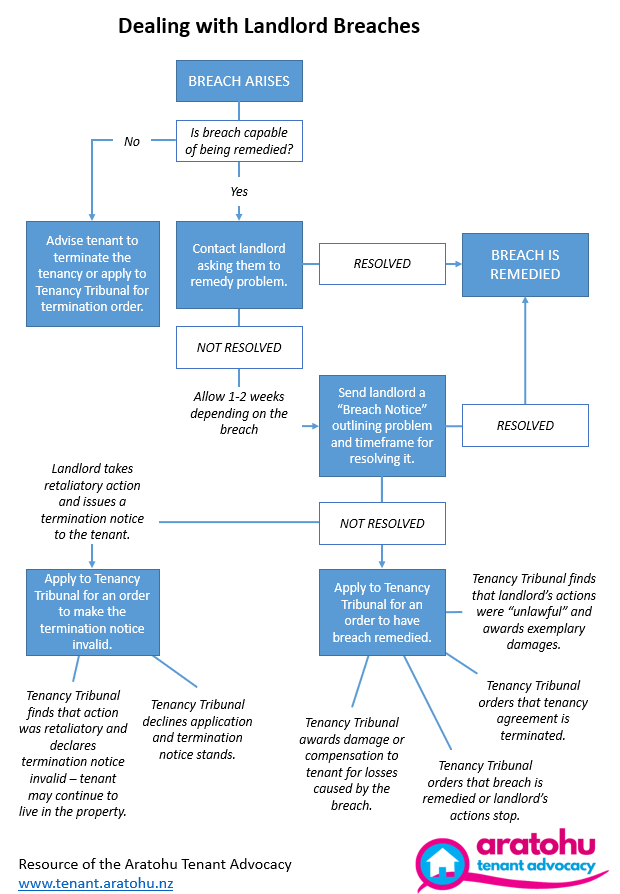When problems arise with a landlord, it’s generally best if the tenant can talk to them directly, or with the support of an advocate, to try and resolve things. This approach is sometimes referred to as ‘self-resolution’ and will often be less stressful and time-consuming than using formal dispute resolution options.
How to raise issues with the landlord
Tenancy Services guide to self-resolution
If the tenant and landlord are able reach agreement
Tenancy Services FastTrack Resolution service
If the tenant and landlord are able to resolve the dispute and reach agreement, they can use the Tenancy Service’s FastTrack Resolution service to formalise the agreement.
Once the agreement is confirmed by a mediator and sealed (stamped) by the Tenancy Tribunal, it becomes a legally binding court order.
FastTrack Resolution can be particularly useful for coming to agreement on issues such as how the tenant will pay overdue rent or other money that they owe.
Once FastTrack Resolution is applied for, mediation is no longer an option. If anything goes wrong, the case will be referred to the Tenancy Tribunal.
Find out more about FastTrack Resolution
If the tenant and landlord are not able reach agreement
If it’s clear that a landlord is breaching the tenancy agreement or failing to meet their legal obligations and the tenant has not had any success trying to sort things out, then they may be able to resolve the dispute by going to mediation or applying for a Tenancy Tribunal hearing. The following flowchart shows strategies for dealing with landlord breaches.
How the Tenancy Tribunal works
The Tenancy Tribunal is an independent judicial body that provides a relatively quick, informal and inexpensive way for tenants and landlords to resolve disputes, normally without involving lawyers.
The Tenancy Tribunal can only hear cases covered by the RTA
The Tenancy Tribunal can only hear cases between tenants and landlords in residential tenancies that are covered by the Residential Tenancies Act (s 77(1) RTA ). They can hear disputes involving claims up to $100,000.
The Tenancy Tribunal does not deal with disputes between flatmates, or disputes in private boarding situations, because these relationships are not governed by the Residential Tenancies Act. These disputes are generally dealt with in the Disputes Tribunal.
What tenancies are covered by the Residential Tenancies Act
What tenancies are not covered by the Residential Tenancies Act
Find out more about the Disputes Tribunal
How the Tenancy Tribunal resolves disputes
The Tenancy Tribunal can resolve disputes in two ways. They first consider if mediation would be appropriate. The applicant can also specify that they would like the dispute to go to mediation as the first step. If mediation is unsuccessful or inappropriate, a hearing by a Tenancy Tribunal adjudicator will be scheduled. If mediation is successful then the case may not need to go to a Tenancy Tribunal hearing.
Both mediation and the Tenancy Tribunal are intended to be forums where people are not intimidated by the legal process and where commonsense solutions to disputes are worked out in a non-confrontational way. The Tribunal makes decisions about disputes based on general principles of the law and the merits and justice of the case. It doesn’t have to follow strict legal technicalities.
Tip
If a tenant is notified that a landlord has taken a case against them to the Tenancy Tribunal, they should first try to resolve the issue with the landlord or request mediation. If this is not possible, and a Tenancy Tribunal hearing is going ahead, they should gather evidence to defend any claims made by the landlord. If the tenant has legitimate issues with the landlord that they want resolved at the same time, they can file a cross-application.
Mediation may be the first step
The Tenancy Tribunal’s mediation service encourages landlords and tenants to settle disputes in cooperative, non-confrontational ways and by mutual consent.
How mediation works
A trained mediator will help the tenant and landlord discuss the problem, identify the key issues in dispute and work through possible solutions. The mediator does not make any decisions about the dispute themselves.
The mediator will record an order that summarises what has been agreed to.
This order is legally binding and enforceable once it is sealed (stamped) by the Tenancy Tribunal. Agreements reached in mediation are confidential and not available online.
Where a matter cannot be resolved between a landlord and a tenant, either party (and not anyone else) can have that matter referred to the Tenancy Tribunal for an order or decision.
Tenancy Tribunal hearings
Tenancy Tribunal hearings are conducted in a less formal way than court hearings but follow the same overall procedure. Rather than a judge, the case is run by an adjudicator.
Usually, the adjudicator will work through the hearing issue by issue, giving both parties an opportunity to respond.
In most cases, tenants and landlords must represent themselves in hearings. They cannot typically use advocates or lawyers to represent them, but they can bring a support person.
Representation at Tenancy Tribunal hearings
Find out more about what happens at a Tenancy Tribunal Hearing
What happens after the hearing
After the Tenancy Tribunal hearing, the Tribunal will issue an order. The order will record what happened at the hearing and will outline the decisions made. The order is legally binding and can be enforced by application to the Ministry of Justice.
Both the tenant and the landlord have the right to request a rehearing or appeal if they feel that the decision was substantially wrong or if a miscarriage of justice has occurred.
Last reviewed on 15 Apr 2025

